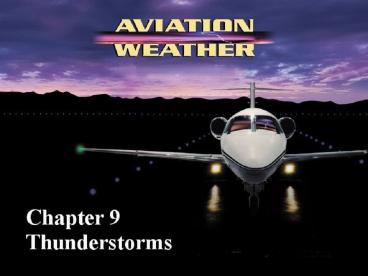Aviation Weather PowerPoint PPT Presentation
1 / 36
Title: Aviation Weather
1
(No Transcript)
2
Dry convection
- Superadiabatic layer
- LRgt3C/1,000
- Very unstable air
- Creates bubble of air
- Thermals
- Few hundred to few thousand feet wide
- Lifetime 5 to 10 minutes
- Vertical speeds of up to 2,000 feet per minute
3
Dust Devil
- Air around obstructions creates eddies
- If thermal forms in the same area you get Dust
Devils - Speed up to 20 kts
- Light wind hot surface
- 5 100 wide
- 100 300 ft. high
- 4 minutes or less
4
Vortex Ring
- Thermals have distinct internal circulation
- Narrow core of upward motion
- Surrounded by weaker sinking motions
- Draws outside air into the thermal as it rises
- Halts when it reaches stable air
5
Cloudy convection
- Convective condensation level
- Flat base of the clouds where air first reaches
saturation - Above air cools at the SALR
- Equilibrium level
- Updraft temperature is equal to the surrounding
air so updraft slows - Cloud top is where the updraft stops
6
Downdraft development
- Precipitation induced
- When the cloud top exceeds the freezing level
- Updraft can no longer support the large
particles, they begin to fall dragging air with
them.
7
Thunderstorm structures / types
- Airmass thunderstorm
- Severe thunderstorm
- Single cell
- Supercell
- Multicell
8
Thunderstorm Stages
- Cumulus stage
- Air rises throughout cloud
- Grows to 20,000
- Reaches next stage of development in 15 minutes
9
Thunderstorm Stages
- Mature Stage
- Begins with rain
- Lightning and thunder start
- Downdrafts produce gusty surface winds
- Develops anvil shaped top (reached the
Stratosphere gt36,000)
10
Thunderstorm Stages
- Dissipating Stage
- Begins in about 30 minutes
- Downdrafts cut off updrafts
- Takes on a stratiform appearance
- Life of a single-cell thunderstorm is usually
lt hour
11
Products of thunderstorms
- Tornados
- Hail
- Lightning
12
Multicell Thunderstorms
- Compact cluster of thunderstorms
- Airmass thunderstorms at different stages
- Cell Regeneration
- Storms vary in intensity
13
Supercell Thunderstorm
- Occurs in middle latitudes (most common in
southern Great Plains in summer)
- Much larger
- Updrafts and downdrafts dont mix
- Steady-state
14
Supercell Thunderstorm
- Right side (NW) is downdrafts
- Left side (SW) is rain-free flanking line
- Middle (W) is main updrafts
- Tornadoes occur here
15
Tornadoes
- Winds exceeding 180 kts
- Usually associated with severe thunderstorms
- Diameters from 300 to 2,000
- Move SW to NE at 30 kts
- Funnel clouds Water-spouts
16
Hail
- When ice crystals grow we normally expect snow
- Snow collides with water droplets and freeze
(accretion) - Strong updrafts suspend hail
- Can be found in clear air
17
Lightning
- Visible electric discharge
- Several forms
- In-cloud, cloud-to-cloud, cloud-to-ground, sheet
lightning, heat lightning. - 300,000 volts per foot, 50,000F
- Typically 3-4 flashes per minute
18
Requirements for development
- Sufficient water vapor
- Unstable lapse rate
- Initial upward boost (lifting)
19
Instability patterns
- Lifted index
- Difference between observed temperature at 500 mb
and temperature a parcel of air lifted from
surface to 500 mb - If observed is colder than lifted, then the
lifted index is negative (unstable) - Lifted index evaluates the severity of the
thunderstorm not the probability
20
Instability patterns
- K index
- Useful in determining the probability of a
thunderstorm - T Temp, D Dewpoint
21
Stability Chart
22
Weather Radar
- Uses electromagnetic radiation to detect objects
- Consists of a transmitter and a receiver
- Doppler Radar
- Has the ability to determine the velocity
- NEXRAD
- More powerful Doppler radar
- Can determine winds at a distance of 60 miles out
23
Color Radar
- Black 0 20 dbz
- Green 20 30 dbz
- Yellow 30 40 dbz
- Red gt 40 dbz (1/2 inch of rain per hour)
- Flashing Magenta gt50 dbz
24
Is It A Hazardous Storm?
- Is the atmosphere significantly unstable?
- Dewpoint gt 10C?
- Temperature/dewpoint spread gt 17C?
- Movement gt 10kts?
- Visible evidence?
- Southernmost cell in a line?
25
How Hazardous Is It?
- Height greater than 15,000?
- Gradient or shape asymmetrical?
- Reflectivity gt 50 dbz?
- Casting a shadow?
26
Round or Oval Shape
27
Gradients
28
Gradients
29
Pendant Shape
30
Notches, Fingers, Hooks
31
Radar Shadows
32
Thunderstorm Avoidance
- Don't land or takeoff in a thunderstorm
- Don't attempt to fly under a thunderstorm
- Don't fly without airborne radar into embedded
thunderstorm - Do avoid by at least 20 miles any thunderstorm
33
Thunderstorm Avoidance
- Do clear the top of a known severe thunderstorm
by at least 1,000 feet altitude for each 10 knots
of wind speed - Do circumnavigate the entire area if the area has
6/10 thunderstorm coverage - Lightning indicates the probability of a strong
thunderstorm.
34
Thunderstorm Avoidance
- Do regard as extremely hazardous any thunderstorm
with tops 35,000 feet or higher
35
Thunderstorm Penetration
- Tighten your safety belt
- Hold your course, dont turn back
- Penetrate below the freezing level or above the
level of minus 15 degrees Celsius to avoid
critical icing conditions - Establish power settings for turbulence
penetration airspeed
36
Thunderstorm Penetration
- Turn up cockpit lights
- Do maintain constant attitude let the aircraft
"ride the waves."

